|
|
|
Sort Order |
|
|
|
Items / Page
|
|
|
|
|
|
|
| Srl | Item |
| 1 |
ID:
073583
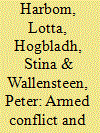

|
|
|
| 2 |
ID:
073579
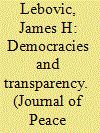

|
|
|
|
|
| Publication |
2006.
|
| Summary/Abstract |
This study assesses participation in the UN Register of Conventional Arms (UNRCA) in its first decade (1992-2001) of operation to determine the effects of democracy on international transparency. First, the function of the UNRCA is discussed. Second, transparency is defined and then explained by democracy and factors recognized in two international politics theories: realism, which emphasizes the effects of state capabilities and interests, and liberal institutionalism, which stresses the facilitative role of international institutions. Third, preliminary judgments are offered based on the frequency and nature of participation in the UNRCA, the consistency between export and import reports to the register, and participation in the register by democracies and non-democracies. Fourth, a cross-sectional time-series logit model is specified and tested to determine the relative effects of democracy on participation in the UN register. The study concludes that existing international politics theories go a long way toward accounting for patterns of openness and deception in international politics but not the full extent that security policies owe to domestic structures and processes.
|
|
|
|
|
|
|
|
|
|
|
|
|
|
|
|
| 3 |
ID:
073581
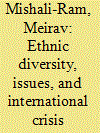

|
|
|
|
|
| Publication |
2006.
|
| Summary/Abstract |
Ethnic conflict is prominent and recurrent in contemporary world politics, expressed in both internal and international disputes. The main goal of this study is to link ethnic conflict at the state level and its spillover to international conflict and crisis. More specifically, it examines the relationship between particular ethnic dimensions and international crises. The examination focuses on ethnic diversity among adversaries and ethnic issues within interstate confrontations, and their effects on crisis dynamics. The analysis links two major datasets: the Minorities at Risk (MAR) Project, which characterizes worldwide ethno-political actors of several types, and the International Crisis Behavior (ICB) Project, which analyzes international conflicts and crises across the world. Analyses of 133 ethnic-related international crises in the period 1918-2002, in which 67 ethno-political actors were involved, reveal the multidimensional impact that ethnicity has upon international conflict. Ethnic conflict increases the complexity and danger inherent in international crisis. The presence of ethnic diversity extends crisis duration, increases the level of its violence, and impedes accommodative crisis outcome. Moreover, the changing world order is characterized by a shift in the issue agenda. Ethnic issues related to identity and to political and economic status, which mainly concern non-state political actors, create both intrastate and interstate confrontations and shape the behavior of major actors on the world stage. Different ethnic issues in crises have diverse influences on crisis process and outcome.
|
|
|
|
|
|
|
|
|
|
|
|
|
|
|
|
| 4 |
ID:
073577
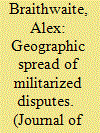

|
|
|
|
|
| Publication |
2006.
|
| Summary/Abstract |
A thriving literature investigates the claim that geographic processes cause military conflict to cluster and diffuse. With the recent update of the Militarized Interstate Dispute (MID) data and the collection of geographic locations to accompany these data, it is now possible to offer a location-based examination of the geographic spread of conflict. Consideration of the literature that identifies a role for physical geography in conflict processes leads to the derivation of hypotheses in which territory and resources are expected to provide incentives for states to seek to increase territorial acquisitions, while impassable terrain is expected to act as a barrier to such spread. These hypotheses are tested using ordinary least squares (OLS) estimation - regressing the spread of individual MIDs in the years 1993-2001 upon a range of location- and dispute-specific variables. These regressions demonstrate that the spread of individual disputes is a function of the issue over which they are fought, the presence of vital resources in the host country, the prevailing terrain of that country, and the relevant conflict history of the participants. It is argued that knowledge of the precipitants of the spread of individual conflicts is of great benefit to policymakers seeking to mitigate the detrimental impact of conflict upon the societies in which it occurs, as well as to those deploying peacekeeping troops to conflict zones.
|
|
|
|
|
|
|
|
|
|
|
|
|
|
|
|
| 5 |
ID:
073578
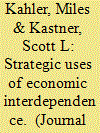

|
|
|
|
|
| Publication |
2006.
|
| Summary/Abstract |
While the determinants and effectiveness of economic sanctions have been the subject of a substantial and growing literature in international relations, much less attention has been given to economic engagement strategies, where a country deliberately expands economic ties with an adversary to change the target's behavior. This article develops a theoretical framework that distinguishes between three types of engagement strategies: conditional policies that directly link economic ties to changed behavior in the target state; unconditional policies where economic interdependence is meant to act as a constraint on the behavior of the target state; and unconditional policies where economic interdependence is meant to effect a transformation in the foreign policy goals of the target state. The article presents several hypotheses concerning the conditions facilitating or hindering the successful implementation of these different strategies, and then examines engagement policies adopted by three East Asian states: South Korea, Taiwan, and mainland China. The cases offer preliminary confirmation of at least three of the hypotheses: conditional strategies are less likely to succeed when the initiating state is a democracy; transformative strategies are more likely to succeed when the target state is a democracy; and transformative strategies are more likely to succeed when a broad consensus exists in the initiating state.
|
|
|
|
|
|
|
|
|
|
|
|
|
|
|
|
| 6 |
ID:
073580
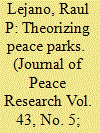

|
|
|
|
|
| Publication |
2006.
|
| Summary/Abstract |
In a reversal of the historical role of territory in intergroup conflict, the article focuses on an emergent notion of territory as an instrument for peace. In this article, the author begins to theorize about the mechanisms by which so-called peace parks might act in resolving conflict and ushering in regional stability. Two models are utilized that differ in their portrayal of how these parks might work. The first model, built on a game-theoretic foundation, provides insight into incentive mechanisms by which parties might agree to a border park. Furthermore, the model sheds light on whether these parks might serve as vacant buffer zones or, alternatively, active zones of cooperation. However, the game-theoretic model should be complemented by another, qualitative model that focuses primarily on how these interactions are embedded in history, culture, tradition, and group identity. To this end, the author develops a second model, which portrays institutions as structures of care. In the model of care, relationships are constitutive of identity, and institutions and practices (including war and peace) evolve in coherence with the web of relationships. It is the employment of mutually complementing analytics that might afford a deeper understanding of how these peace parks might actually serve as effective bridges for peace.
|
|
|
|
|
|
|
|
|
|
|
|
|
|
|
|
| 7 |
ID:
073582


|
|
|
|
|
| Publication |
2006.
|
| Summary/Abstract |
Media pools have frequently been deployed by the US military during the past 25 years, and there has been much written about the effects and limitations of their use in particular cases. The military actions reviewed in this study are troop deployments to Bosnia and Herzegovina, Grenada, Haiti, Iraq, Lebanon, Libya, Panama, and Somalia, all of which resulted in the loss of American lives. The research examines whether there is a correlation between the characterization of the intervention as it is presented in media pool stories and the shifts in public opinion during this range of US military interventions. The examination shows that (1) when US media are constrained by military pooling, then the military intervention is characterized by the media as facilitating political change, and the public opinion is initially favorable; and (2) when US media are not constrained by military pooling, then the military intervention is characterized by the media as facilitating humanitarian efforts, and the public opinion is initially less favorable. This evidence also suggests a savvy practice of agenda-framing and second-level agenda-setting among military operations planners who determine the implementation of media pooling. The evidence also suggests the need for additional attention by researchers interested in the variables of second-level message-framing effects during those periods when both media and audiences are vulnerable to message management.
|
|
|
|
|
|
|
|
|
|
|
|
|
|
|
|
|
|
|
|
|